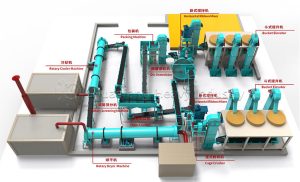In the wave of sustainable agriculture, an innovative technology is quietly transforming how we view waste. Oil palm empty fruit bunch (OPEFB), once considered plantation residue, is now being elegantly converted into efficient organic fertilizer through disc granulation production line. This is not just a revival of waste; it’s a vivid practice of circular agriculture.
Imagine: OPEFB, a by-product of palm oil production, is rich in fiber but difficult to decompose naturally, often piling up and causing environmental burdens. However, when it enters a modern fertilizer production line, everything changes. Through processes like crushing, mixing, granulating, and drying, the disc granulator transforms these loose fibers into uniform, sturdy granules. The disc’s rotating design ensures that materials naturally form pellets layer by layer, much like rolling a snowball, resulting in consistent fertilizer products.
But OPEFB fertilizer production doesn’t stop there. It often works in synergy with other equipment: crushers to refine raw materials, mixers to blend additives for nutrient optimization, dryers to reduce moisture, coolers to stabilize the granules, and screening and packaging machines to ensure final product quality. This integrated system not only boosts efficiency but also gives the fertilizer slow-release properties, helping to improve soil structure and enhance water retention.
What does this mean for farmers worldwide? It offers a low-cost, eco-friendly fertilizer option that reduces reliance on chemical fertilizers, increases crop yields, and lowers carbon footprints. From plantations in Southeast Asia to farmlands in Africa, OPEFB fertilizer is becoming a star in sustainable agriculture.
In summary, the combination of disc granulation lines and OPEFB is not just a technological triumph but also a testament to ecological wisdom. It reminds us that waste isn’t the end—it’s the start of renewal, paving the way for a greener, more abundant future.



